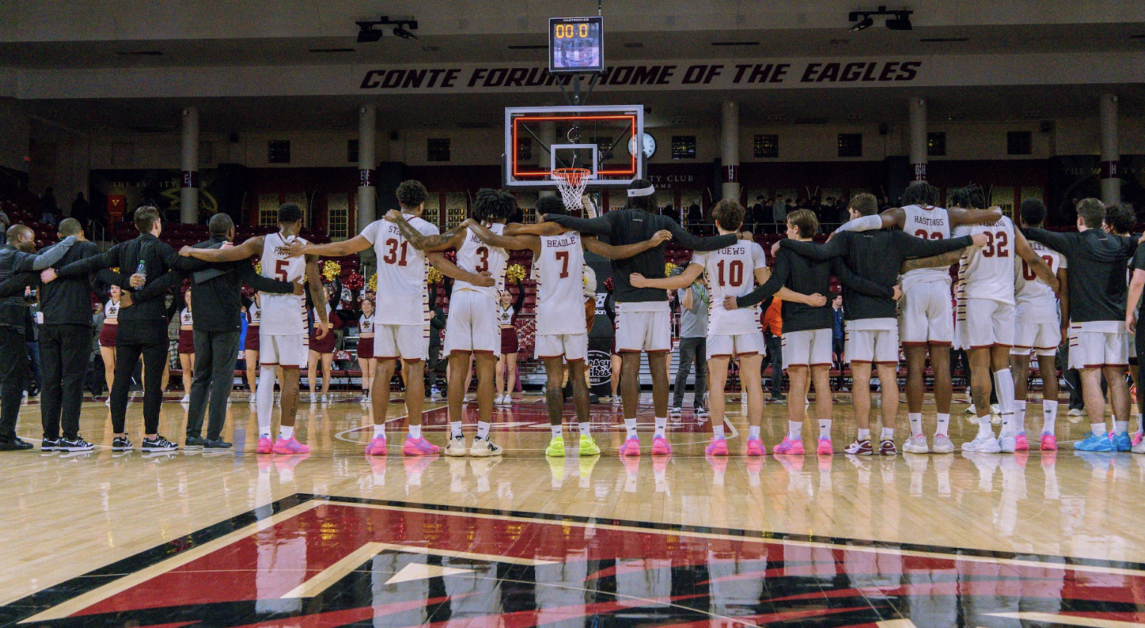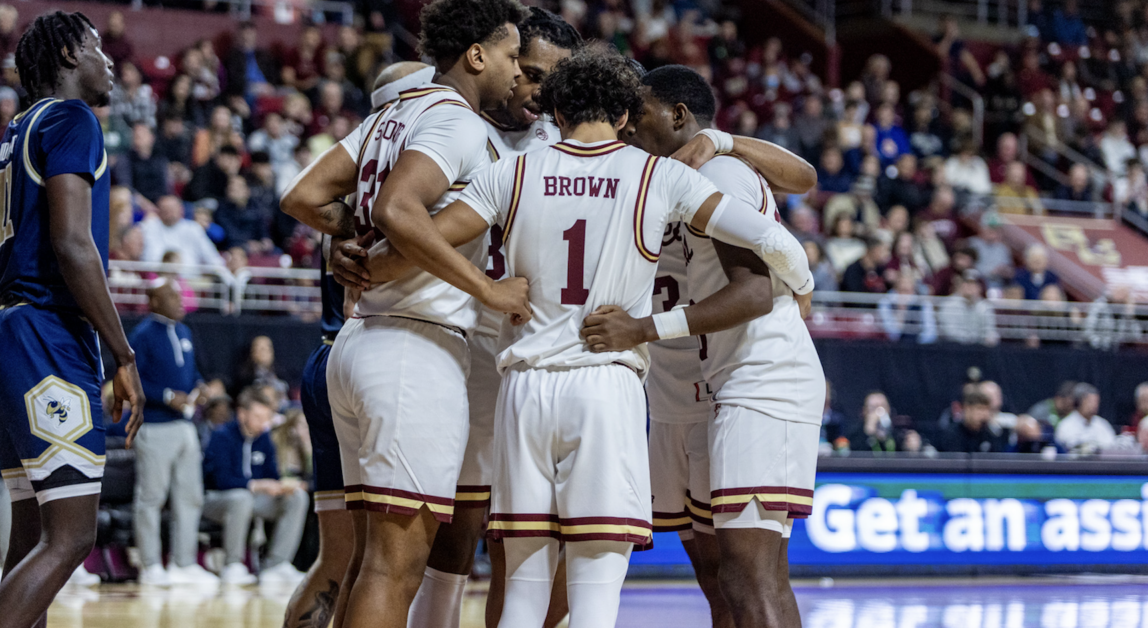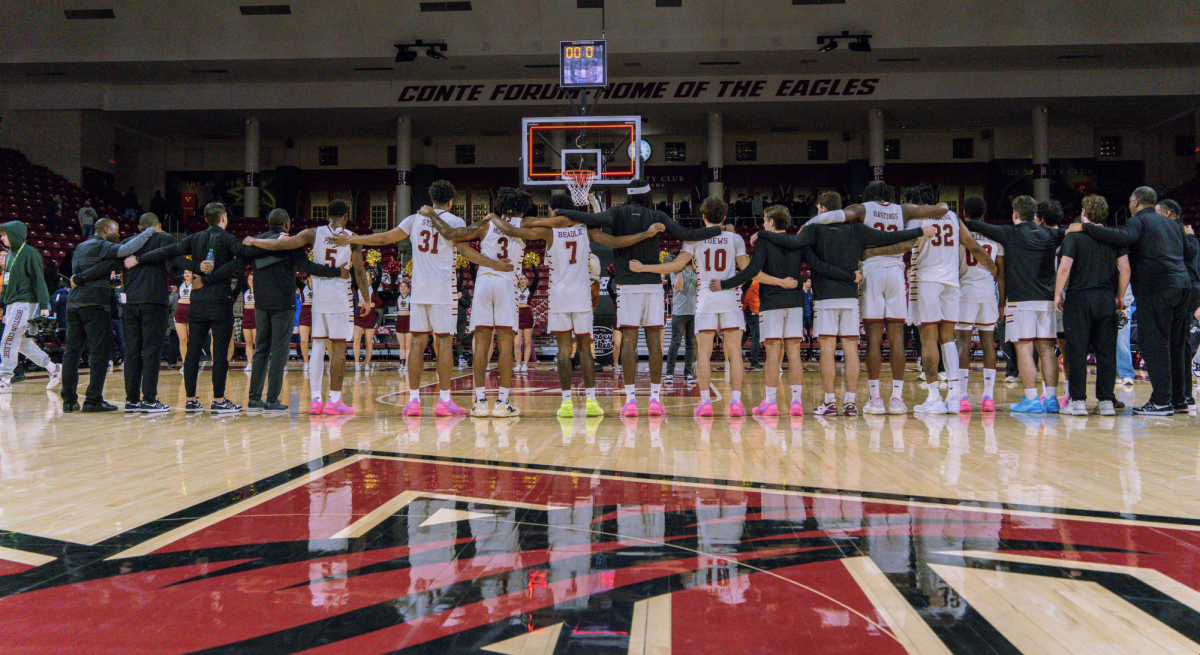Clifford’s big-man presence is huge
By Jim Hill | Heights Staff
Repeat after me: Dennis Clifford, the oft-injured center, is the most important player on the Boston College men’s basketball team. Now once more, with gusto: Dennis Clifford—the big man whose leg injuries kept him off the court for the vast majority of the last season—is the most important player on the BC men’s basketball team.
Understandably, that statement might be difficult to say aloud—because it may just seem downright wrong. After all, head coach Jim Christian’s squad boasts the likes of scoring savant Olivier Hanlan. And, to Clifford’s detriment, the argument in favor of the junior guard is really straightforward: in Hanlan, who had the third-most points points per game in the ACC last season, BC has one of the most talented players in the entire conference.
You have to ask, though: “How far did this singular talent get the squad last season?” Sure, Hanlan clambered to third on the University’s all-time career scoring list, notching his 1,100th point. Meanwhile, though, his team finished with an abysmal 8-24 record, after failing to consistently outscore the opposition. The guard, despite his prowess on the hardwood, could not compensate for the 2013-14 squad’s fundamental flaw. There just wasn’t a proper big man.
The problematic absence of a full-fledged center had an immense effect on the 2013-14 season, as struggles to establish an inside presence without a definitive five took their toll—on both ends of the court. On the offensive end, the squad’s limited options in the key allowed opposing teams to focus their defensive efforts on perimeter shooting, one of former head coach Steve Donahue’s strategic staples. On the defensive end, the team often had difficulty containing or challenging the opposition’s forwards and centers, especially the top-tier forwards and centers of the ACC. Such was the case when Duke’s Jabari Parker romped through the BC lane to the tune of 29 points, leading his Blue Devils to a decisive 89-68 victory over the Eagles. (Of note is the fact that Duke won that game in spite of a 25-point scoring spree on the part of Hanlan.) Perhaps most importantly, both defensively and offensively, the 2013-14 team tallied 117 fewer rebounds than the teams it faced, with a margin of six fewer per contest.
As evidenced by the negative aspects of its play, the primary problem faced by the 2013-14 squad was that of size. The team had the talented playmaker in Hanlan, the architect in Joe Rahon, the elite swingman in Ryan Anderson, and the 3-point specialist in Lonnie Jackson. But an integral piece of the “winning equation” was missing–specifically, a 7-foot-high, 250-pound piece. And so we return to the opening statement: Clifford, the oft-injured center, is the most important player on the team.
Clifford’s importance is not necessarily the result of his talent—though the 7-footer certainly has the ability to make an indelible mark on the 2014-15 season—but instead the result of his facilitating role. He can add much-needed dimensions to the offensive and defensive game plans. He can set picks for mid-range and perimeter shooters and can pose a threat when on either side of the court, with the potential upside of returning to his freshman form.
During the 2011-12 season, Clifford recorded a team-high 29 blocks and averaged 9.1 points per game while shooting a team-best .529 from the field. Additionally, and very importantly, he can rebound. In the two games Clifford played last season, before medical redshirting, the center snatched nine rebounds over the course of a combined 33 minutes of play.
Clifford also brings a sense of consistency to the team. He’s the squad’s stalwart veteran—a player who, while benched last season, hollered tips and instructions to forward Will Magarity. He’s someone who played before Hanlan’s freshman year, and he’s someone who’s stayed after the firing of Donahue and the transfer of Anderson—a player whose rebounding was unmatched and whose scoring only Hanlan rivaled. In the wake of a new coach’s hiring and the departure of the squad’s star forward, causing another gap in the roster, Clifford is especially essential.
“Just being the biggest guy out there, I really … have to act like a leader,” Clifford once said in a 2012 interview. “Defensively and offensively, getting the guys situated and making sure they’re as confident as I am.”
Hanlan’s scoring ability remains key
By Conor Finn | For The Heights
As Jim Christian embarks on his first season at the helm of the Boston College’s men’s basketball team, he looks to turn around a program that finished last season with an 8-24 record. Although the 2013-14 season was nothing short of a full-fledged disaster, BC still returns Olivier Hanlan, who finished third in the ACC in points per game last season.
With the departures of Joe Rahon and Ryan Anderson, Christian arrives in Chestnut Hill looking to pick up the pieces of a team that lacked much of an identity last year on its way to finishing second to last in the ACC.
Last season, the BC offense lacked direction at times with the confusion of point guard duties, even with tasks as simple as bringing the ball up the court, between Rahon and Hanlan. While that confusion affected the team’s offensive efficiency last season, that should not be the case this year, as BC moves forward without Rahon. The Eagles’ primary ball handler will undoubtedly be Hanlan, who is gearing up for a huge year as the Eagles’ primary scoring option and offensive facilitator. Christian’s offense preaches the central importance of the point guard as the offense’s main agent and operator.
In 2013, Christian’s Ohio University offense was responsible for creating the MAC Player of the Year in D.J. Cooper. Hanlan will be expected to, and also has the capability to, step into that role of reliable scorer and offensive facilitator. This central role for Hanlan, along with the skills that he displayed in his first two seasons as an Eagle, make him the most important player for the success of the 2014-15 BC Eagles.
No player on the BC roster approaches the potential that Hanlan has for this season. Hanlan has averaged 15.4 and 18.5 points in his freshman and sophomore seasons respectively—no returning player on the roster has averaged more than eight points per game during his time at BC. Hanlan’s scoring presence is enough to justify his status at most important player to the team’s success. When Hanlan is able to score and do it efficiently, he will put the team in a position to achieve success.
More than just serving as the team’s primary scorer, Hanlan needs to succeed in getting the ball to his teammates in situations in which they can thrive. This represents an area of Hanlan’s game that he can improve upon, and he has teammates who will rely upon him. With outside threats Patrick Heckmann, Aaron Brown, and Edie Odio, and the return of Dennis Clifford in the post, the Eagles have weapons that can serve as great complements to Hanlan in achieving success.
This period of BC basketball could be termed and, perhaps rightly should be termed, a transition period. There is an entirely new coaching staff, and last year’s second and third leading scorers have fled for greener pastures. Not many people have high expectations for the Eagles—they’re predicted to finish 14th out of 15 teams in the ACC preseason coaches’ poll.
This is a team in need of leadership and a strong start under the new regime of Christian, and Hanlan is the best player to fill that role. To succeed in the ACC, a conference becoming more competitive with the passage of each season and the addition of basketball powers like Syracuse, Pittsburgh, and Louisville, BC will need the lightning rod that Hanlan can be for the team.
Since the Canadian product arrived in Chestnut Hill, he has led the team in scoring and carried the load for a team that has failed to achieve very much at all, outside of an upset over No. 1 Syracuse last year.
In a new system that hopes to capitalize upon his skills, this is the time for Hanlan. For a player who hopes to one day play in the NBA, this is Hanlan’s opportunity to make a mark on the college basketball landscape and ignite a—pun intended—rebound season for the Eagles.
Featured Image by Jordan Pentaleri / Heights Graphic


















